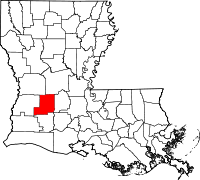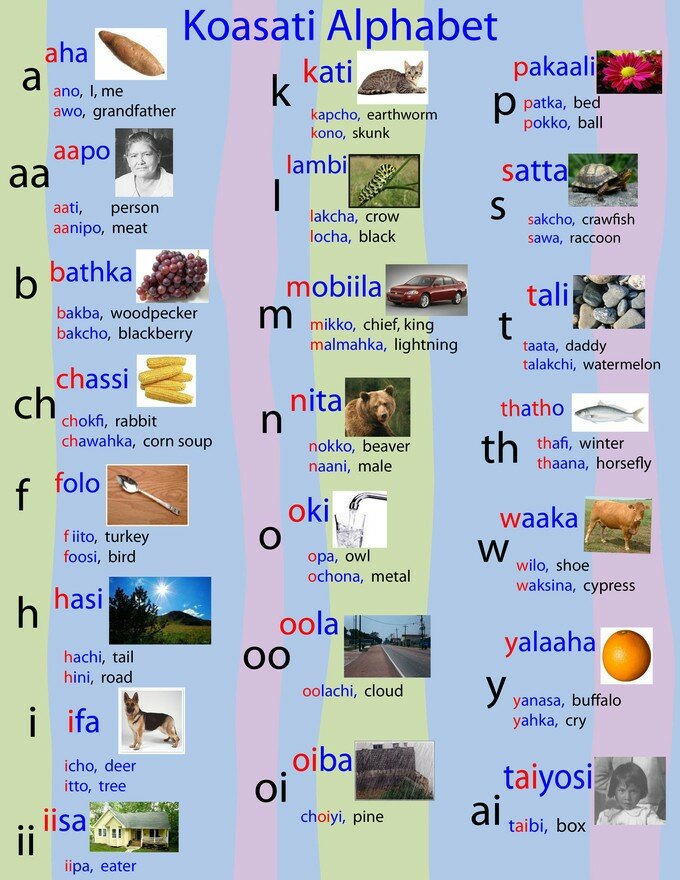About the Koasati Language Project
 Koasati is a living language spoken by members of the Coushatta Tribe in Allen and Jeff Davis Parish, Louisiana, just north of Elton, as well as members of the Alabama-Coushatta Tribe in Livingston, TX.
Koasati is a living language spoken by members of the Coushatta Tribe in Allen and Jeff Davis Parish, Louisiana, just north of Elton, as well as members of the Alabama-Coushatta Tribe in Livingston, TX.
Koasati belongs to a family of languages called the Muskogean family. The other members of the family are Choctaw, Chickasaw, Alabama, Apalachee, Mikasuki (Hitchiti), and Creek (Muskogee).
The first word list in Koasati was collected by Albert S. Gatschet in Indian Territory (Gatschet 1885). John R. Swanton later conducted fieldwork in Louisiana and collected additional vocabulary and two series of texts (Swanton n.d.), some of which have recently been edited and translated (Kimball 2010). Mary R. Haas briefly conducted fieldwork in the 1930’s, but her notes are as yet unpublished. John L. Fischer made several sound recordings in 1963, now housed at the National Anthropological Archives (Fischer 1963). In 1992 David Rising published a thesis on switch-reference in Koasati (Rising 1992). The most extensive documentation has been carried out by Geoffrey D. Kimball, who has published a reference grammar (Kimball 1991), dictionary (Kimball 1994), and texts (Kimball 2010).
In partnership with McNeese State University, The Coushatta Tribe of Louisiana received an NSF Documenting Endangered Languages (DEL) grant in May 2007 (award #0804096) to record, transcribe, and translate Koasati conversations. The major activities of the language documentation project have been accomplished through community-wide workshops with 30 or more participants. Every decision at every workshop has been made by tribal members, and all of the workshops have incorporated hands-on activities so that tribal members acquire language documentation skills. Major accomplishments to date include:
- Development of an approved Koasati orthography – June, 2007.
- Exercises and games to practice writing Koasati and brainstorming to create a topical dictionary using the new spelling system – January, 2008.
- Weekly transcription sessions and a Koasati newsletter – Spring 2008.
- Daily elicitation and recording sessions – June 2008. These meetings included training for tribal members in language documentation methodology provided by Dr. Jack Martin and linguistics students from The College of William & Mary.
- Completion of a 1,200-word topical “talking” Koasati dictionary distributed to each tribal family – August 2008.
- Transcription training workshop; bilingual tribal members do all transcription of texts using FieldWorks Language Explorer (FLEx) and ELAN – January, 2009.
- Recording of 36 Koasati lessons as preparation for a language class – June, 2009.
- Weekly language documentation and transcription sessions to develop a “talking” phrase book and teaching grammar – Fall 2009 - ongoing.
The PI’s, REU students and consultants have generated approximately 80 hours of digital video and audio of both elicited and naturally occurring conversational Koasati. Approximately 30% of this material has been transcribed and translated in FLEx and reviewed with the project consultants, Dr. Jack Martin and/or Dr. Geoffrey Kimball. These materials are gradually being posted at the Koasati Language Project site and at the Creek Archives (http://lingspace.wm.edu) for use by the scholarly community and will eventually form part of a tribal museum.
Although the Coushatta Tribe has received local and regional attention for its grass-roots, community-based approach to language documentation, it has become clear to everyone involved in the DEL project that there are still basic gaps in our understanding of Koasati, particularly in the area of pitch contrasts. No previous researchers ever conducted instrumental studies of Koasati or attempted to make generalizations with a representative sample of speakers. Moreover, the pitch contrasts found in nouns and in different aspectual forms of verbs differ considerably from published accounts of the language. Through an ongoing phonetic study (NSF award #1065334), linguists Dr. Jack Martin (William & Mary) and Dr. Matthew Gordon (University of California, Santa Barbara) are studying and documenting the pitch accents in nouns and verbs and the rich intonation system found in Koasati.
This material is based upon work supported by the National Science Foundation under Grants No. 0804096 and 1065334. Any opinions, findings, and conclusions or recommendations expressed in this material are those of the author(s) and do not necessarily reflect the views of the National Science Foundation.
Koasati Alphabet
The Koasati alphabet was developed by the Koasati Language Committee in June, 2007, and subsequently ratified by the tribal community.
- a a-ha, sweet potato
- aa aa-ti, person
- b bak-ba, woodpecker
- ch chok-fi, rabbit
- f fii-to, turkey
- h ha-si, sun, clock
- i i-fa, dog
- ii ii-sa, house
- k ka-ti, cat
- l lam-bi, caterpillar
- m mo-bii-la, car
- n nok-ko, beaver
- o o-ki, water
- oo oo-la, town
- p pa-kaa-li, flower
- s sat-ta, turtle
- t ta-li, rock
- th tha-tho, fish
- w waa-ka, cow
- y ya-na-sa, buffalo
Sometimes vowels can be combined:
- ai taibi, box
- oi oiba, rain
- aw sla-kaw-ka, jack
When a vowel is nasal (said through the nose), it’s underlined: a; i; o
- a no-ta, under
- aa skaa-fo-to, mint
- i
- ii
- o in-ko, no
- oo
Special thanks to the members of the Koasati Language Committee, the Coushatta Tribal Council, and the Coushatta Heritage Department for their work in preserving and promoting the Koasati language. Special thanks also go to Dr. Linda Langley, of McNeese State University, Dr. Jack Martin, Stephanie H. Berryhill, and linguistics students of the College of William and Mary, for their assistance in and dedication to this work. This work would not have been possible without the countless hours of time volunteered by the members of the Koasati Language Committee, especially:
Ronnie Abbey, Iwana Barnard, Doris Battise, Margie Battise, Ed Celestine, Darlene Dunnehoo, Nina Fuselier, Claudine Hasting, Jaime Hill, Dakota John, Jonas John, Marian John, Margaret John, Barbara Langley, Bertney Langley, Jeanette Celestine Langley, Loris Langley, Paula Manuel, Regina “Tee” LaBuff, Kathy Peoples, Clifford Poncho, Jamison Poncho, Lorenda Poncho, Geraldine Reed, Adrian Sylestine, Delson “Dan” Sylestine, Janice Sylestine, Terry Sylestine, Elizabeth Marie Thompson, Leland Thompson, Carol Whitworth, Crystal Williams, Heather Williams, Loretta Williams, Norman Williams and Rodney Williams.

